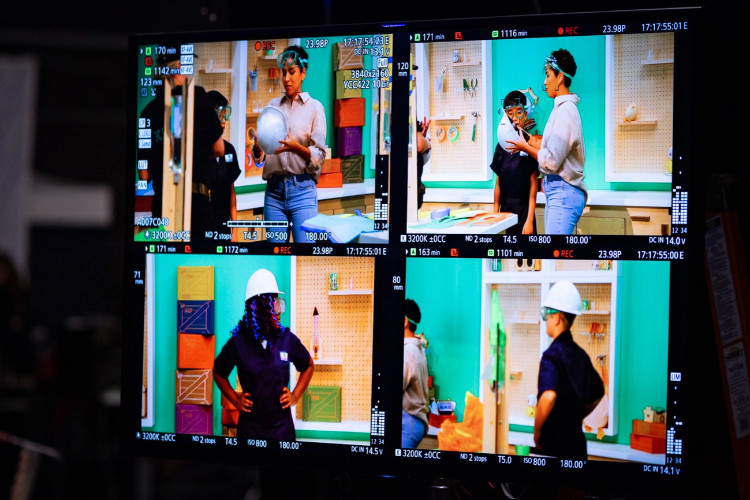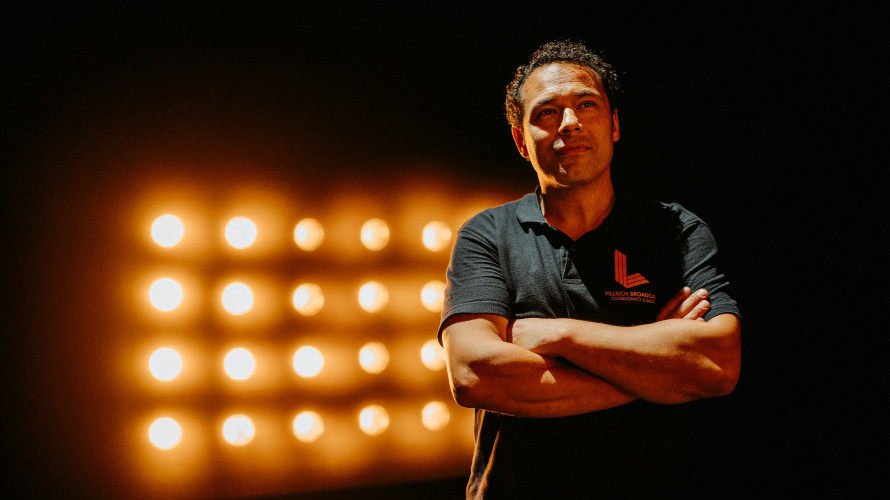Eye to Eye: Sports Production

Author: Bob Pank#
Published 1st July 2010
I was somewhat crestfallen to receive the advice 'Lay off 3D' when I rang TV Bay for guidance on the theme for this month's Eye to Eye. For better or worse, 3D looks set to be a major part of sports television in the coming years. But I picked up my crest, closed one eye and carried on running.
Long-range optics
It is by now quite widely appreciated that zooming into close-up causes very undesirable flattening in 3D. 3ality has an interesting solution which proved one of the most impressive demonstrations at this year's NAB. Its 3D pair cameras are mounted at 90 degrees to each other, one vertical and one horizontal, through a half-silvered-mirror optical combiner. The horizontal camera can be adjusted laterally to increase the effective interocular distance as the cameraman zooms into close-up, and to decrease it during pullback.
Fujinon has meanwhile introduced a range of 3D lenses with zoom and focus servos that are designed to allow the control system to synchronise the optical performance of the left and right cameras. Fujinon’s 3D Synchronous Control System includes the ERD-10A-D01 zoom controller and HJ-303A-06A synchroniser/focus controller. Two cables interface with the 3D controller and lenses to provide the zoom and focus control.
Four new Fujinon 3D high-definition B4-mount zoom lenses are being distributed in Britain by Pyser-SGI: the HA23x7.6BEZD-T5DD with a focal length from 7.6-175 mm (350 mm with 2x extender); the HA18x7.6BEZD-T5DD with a focal length from 7.6-137 mm (274 mm with 2x extender); the HA16x6.3BEZD-T5DD with a focal length from 6.3-101 mm (202 mm with 2x extender); and the HAs18x7.6BZD-T5DD with a focal length from 7.6-137 mm (no extender). The lenses feature Fujinon’s 16-bit synchronous servos as standard but still function as normal when used for 2D. Also available are two new Fujinon 3D extended definition B4 mount zoom lenses: the A4x7.5 BMD-DNL with a focal length from 7.5-30 mm; and the A8x12BMD-DNL with a focal length from 12-96 mm.
Sports gatherings that have hitherto been televised in SD are increasingly being covered in HD. Camera Corps, which provides television support systems for many of the world's largest outdoor events, has developed for an upcoming international football series a new compact HD goal-mouth camera system with a wide angle lens. This captures a 125 degree horizontal field of view without curvature distortion, allowing the entire goal mouth to be televised from the rear of the net. A motorised mount enables the camera to be returned to its normal position if struck by an oncoming ball.
Polecam's new Hi-Eye fish-eye HD camera allows an entire room or stadium to be covered from a single viewpoint without need for a pan and tilt mount. Based on a modified Toshiba IK-HR1S, it has a 170 degree ultra-wide-angle field of view yet weighs only 234 grammes. The lens is rated at 5 megapixel equivalent resolution. Up to five Hi-Eye cameras can be controlled from a single Polecam remote control panel. Camera support, housing, cables, RCP and compact recorder are optional.
Hitachi introduced two new 1080i point-of-view cameras at NAB 2010. The DKH100 and DK-Z50 both have 2/3 inch IT CCDs, motorised five-position filter wheel and variable shutter to 1/10,000 s. They are compatible with existing SK-HD1000/ Z-HD5000 control panels. A newly developed 'control teaming mode' is claimed to improve performance for 3D production rig applications. The DK-H100 has 2.3 million pixel IT-CCDs. The DK-Z50 employs the same sensor as the existing Z-HD500 HDTV camera.
Camera/recorders
Although most sports coverage is live, high-quality camcorders still have their place in the OB arsenal. Canon's new XF305 and XF300 professional camcorders also attracted a high level of interest a NAB 2010. Both employ an MPEG-2 4:2:2 50 Mbit/s XF codec for capturing and recording native 1920 x 1080 video onto Compact Flash cards. Combining video, audio and metadata in a single file, the XF305 and XF300 use an MXF file wrapper to maximise compatibility with non-linear editors. Each camcorder is priced under $8,000 and includes three Canon developed and designed native 1920 x 1080 CMOS image sensors. 4:2:2 colour sampling offers twice the colour resolution of HDV and other 4:2:0 formats. The XF305 features HD-SDI output, genlock, and SMPTE time code in/out for multi-camera or 3D productions. The LCD monitor includes waveform monitor and vectorscope displays. It can also show peaking, edge-monitor-focus and magnified image.
With obvious applications for close-up sports coverage, Panasonic's AG-3DA1 is claimed to be the world’s first HD 3D ramcorder capturing to Secure Digital flash memory. A one-piece unit demonstrated in prototype at NAB, it weighs under 3 kg and is equipped with dual lenses plus two 1920 x 1080 2.07 megapixel 3-MOS imagers to record 1080/60i, 50i, 30p, 25p and 24p (native) and 720/60p and 50p in AVCHD. It can record for up to 180 minutes on dual 32 GB Secure Digital cards in Panasonic’s AVCHD PH mode. Features include dual HD-SDI out, HDMI (version 1.4), two XLR connectors, built-in stereo microphone and twin-lens camera remotes.
Sony's new PMW-320 shoulder-mount ramcorder incorporates three 1/2 inch-type HD CMOS sensors and offers the features of the PMW-EX1R plus enhancements such as a scene file system and four-channel audio. A PMW-320K version is supplied with a Fujinon HD lens. The PMW-320 supports multiple frame rate recording such as 59.94i, 50i, and native 23.98P and 25P as well as being 1080i/720P switchable. There is also a choice of a 35 Mbit/s high quality mode, 25 Mbit/s HDV 1080i compatible mode and 25 Mbit/s SD DVCAM recording. Twin memory card slots support up to 280 minutes HD recording time using two 32GB memory cards.
Mobile power
Anton/Bauer has introduced what it terms a 'ground-breaking' battery, the Dionic HCX. This has a 120 watt-hour capacity. After two-weeks without a load, it automatically goes into sleep mode, reducing self-discharge and 'allowing extended storage with nearly zero capacity loss'.
IDX Technology announced the EB-424L 'portable power station', designed for cameras such as the Red One, Sony F23 and Sony F35. Four V-Mount channels allow connection of up to eight Endura lithium ion batteries. The EB-424L provides an XLR output which supplies 12 V and a LEMO output which supplies both 12 V and regulated 24 V. Both outputs can be used simultaneously. An LED warns of low voltage.



































